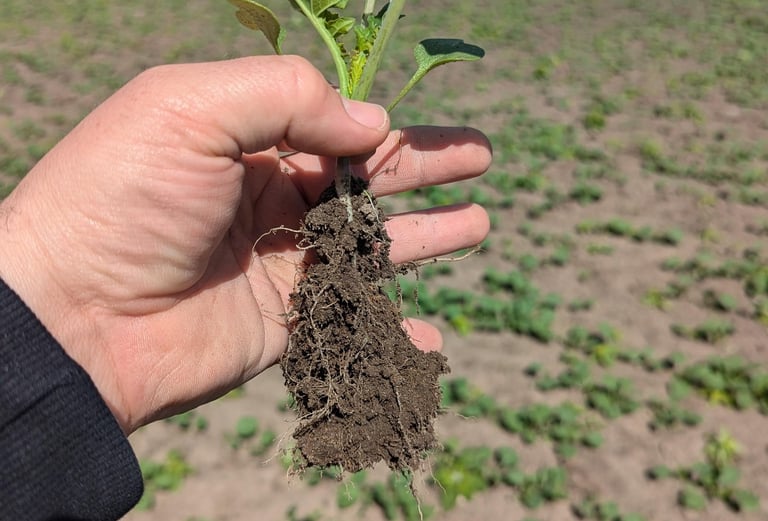Regenerative Farming Practices for Healthy Soil and Biodiversity
REGEN AG


Enhancing soil health is crucial for sustainable and productive farming. This article explores how regenerative farming practices, such as cover cropping, no-till farming, and organic amendments, improve soil structure, boost fertility, and support biodiversity. These practices contribute to carbon sequestration, better water management, and global food security, making them vital for long-term agricultural success.
Soil Health and Regenerative Farming
Soil health is a cornerstone of sustainable agriculture, playing a critical role in the productivity and resilience of farming systems. Regenerative farming practices are designed to improve and maintain soil health, leading to long-term environmental and economic benefits. This article explores the importance of soil health in regenerative farming, with practical insights and resources from leading Canadian and international institutions.
Importance of Soil Health
Healthy soil is essential for growing healthy crops and maintaining sustainable agricultural systems. It provides essential nutrients, supports a diverse ecosystem of microorganisms, and plays a vital role in water retention and carbon sequestration.
1. Nutrient Cycling and Soil Fertility: Soil health is closely linked to its ability to cycle nutrients effectively. Practices such as crop rotation, cover cropping, and the use of compost and organic fertilizers help maintain soil fertility by replenishing essential nutrients and improving soil structure. For more information on nutrient management strategies, refer to the Ontario Provincial Soil Strategy and Agriculture and Agri-Food Canada.
2. Erosion Control and Water Retention: Healthy soils with high organic matter content are better equipped to retain water and resist erosion. This is particularly important in the face of climate change, which brings more frequent and severe weather events. No-till farming, cover cropping, and maintaining vegetative cover are effective strategies for protecting soil from erosion and improving water management. Resources on these practices are available from USDA NRCS and Alberta Sustainable Agriculture.
3. Biodiversity and Ecosystem Services: A diverse soil ecosystem supports a wide range of plant and animal life, contributing to overall farm productivity and resilience. Soil organisms play a crucial role in breaking down organic matter, cycling nutrients, and controlling pests and diseases. Enhancing soil biodiversity through regenerative practices such as reduced tillage, organic amendments, and agroforestry helps build a more resilient and productive agricultural system. Learn more from the Organic Agriculture Centre of Canada and Regen Farmer.
Regenerative Practices for Soil Health
Implementing regenerative farming practices is key to improving soil health and ensuring long-term agricultural sustainability:
1. Cover Cropping: Cover crops protect the soil from erosion, suppress weeds, and add organic matter to the soil. They also enhance soil fertility by fixing nitrogen and improving nutrient availability. More insights on cover cropping can be found in the Provincial Soil Strategy and Agriculture and Agri-Food Canada.
2. No-Till Farming: No-till farming minimizes soil disturbance, preserving soil structure and enhancing water retention. This practice reduces erosion and improves the soil’s ability to store carbon, contributing to climate change mitigation. For more information, visit USDA NRCS and Savory Institute’s Land to Market program.
3. Composting and Organic Amendments: Adding compost and other organic amendments improves soil fertility, structure, and microbial activity. These practices enhance nutrient cycling and support healthy plant growth. Learn more about composting techniques and benefits from the Organic Agriculture Centre of Canada and Regen Farmer.
Global Impacts of Soil Health
Soil health has far-reaching impacts beyond individual farms, contributing to global efforts to combat climate change and ensure food security:
1. Carbon Sequestration: Healthy soils play a significant role in sequestering carbon, helping to mitigate the effects of climate change. Regenerative practices such as cover cropping, agroforestry, and reduced tillage enhance the soil’s ability to capture and store carbon. More information on carbon sequestration can be found at Project Drawdown.
2. Water Management: Healthy soils with high organic matter content improve water infiltration and retention, reducing the risk of floods and droughts. These soils also help maintain clean water supplies by filtering pollutants and reducing runoff. Learn more from the International Water Management Institute (IWMI).
3. Food Security: Maintaining healthy soils is essential for sustaining food production and ensuring global food security. Regenerative farming practices that improve soil health contribute to more resilient agricultural systems, capable of withstanding the challenges of a changing climate. For additional resources, refer to the Ontario Provincial Soil Strategy and Agriculture and Agri-Food Canada.
Soil health is the foundation of regenerative farming and plays a critical role in sustaining agricultural productivity and environmental sustainability. By adopting regenerative practices that enhance soil structure, fertility, and biodiversity, farmers can create resilient systems that support long-term farm profitability and contribute to global environmental goals.
Interested in improving soil health on your farm? Explore resources from the Ontario Provincial Soil Strategy, Agriculture and Agri-Food Canada, and USDA NRCS, and start implementing regenerative practices today!




